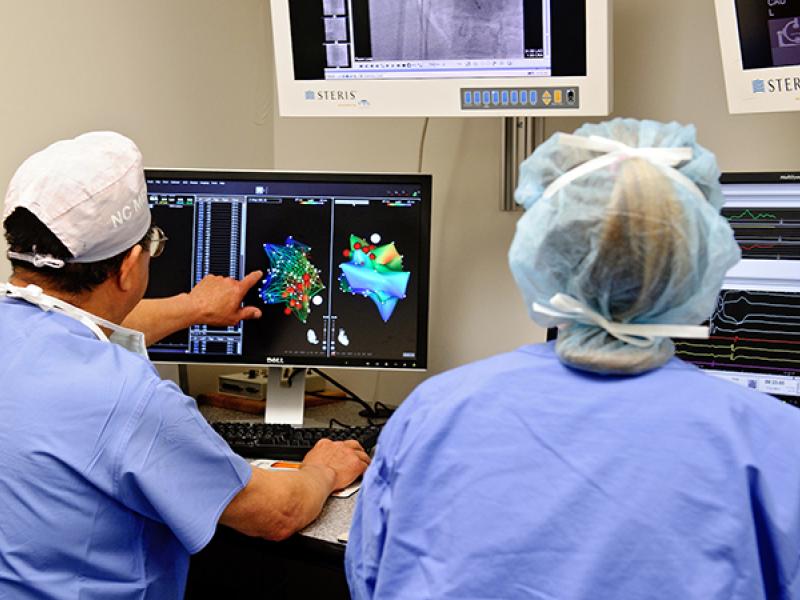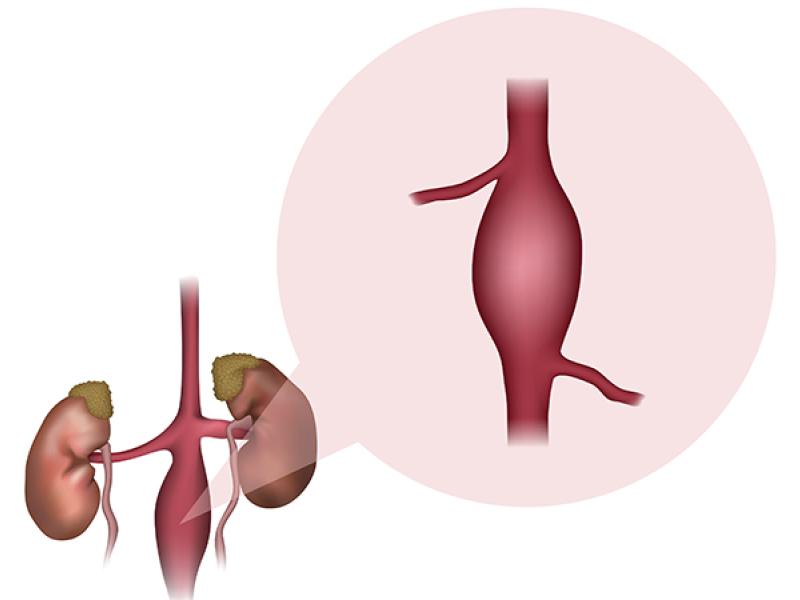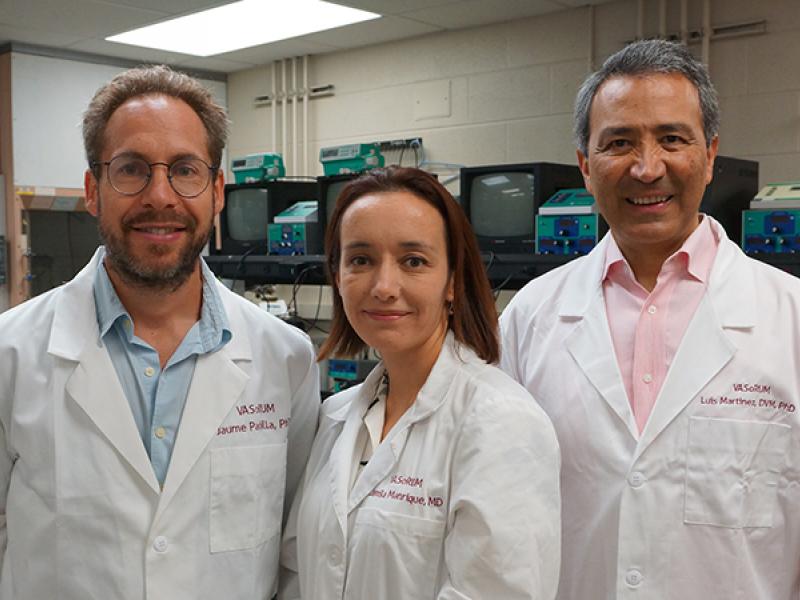The goal of the echocardiography rotation is to gain understanding of the diagnostic capabilities of echocardiography and Doppler. The specific goal is to train all fellows in the performance and interpretation of echocardiography including M-mode, 2-dimensional (2D), 3-dimensional (3D), and Doppler (pulsed wave, continuous wave, color, and tissue).
Every trainee should also understand the following: appropriate indications for echocardiography, fundamentals of ultrasound physics, instrumentation, integration of echocardiography into clinical care including application of hemodynamics, relationship to physical exam, impact of findings on patient management, and relationship to other imaging modalities. Fellows will learn transthoracic (TTE), transesophageal (TEE), stress, and contrast echocardiography. Further training in echocardiography can be offered for those interested in pursuing an academic career in echocardiography and will include advanced training in TEE, stress, interventional, and intraoperative echocardiography. Finally, fellows rotating through the echocardiography laboratory will appreciate their role as a member of the healthcare team, act in a professional manner with other members of the echocardiography team as well as patients, family members, and colleagues caring for patients.
Rotation leaders
- Dr. Senthil Kumar (MUHC)
- Dr. Rachel Littrell (VA)
Objectives
1st year fellow (one to two rotations)
- Perform a complete transthoracic echocardiogram independently and interpret with guidance.
- Understand “knobology” and how to use the machine.
- Identify limitations and artifacts of an echocardiographic examination.
- Recognize the standard views of a TTE.
- Determine left ventricular systolic function.
- Describe echocardiographic parameters used to assess diastolic function.
- Possess the skills needed to execute a limited TTE to answer a clinical question in an emergency setting.
- Classify severity of valvular stenosis and regurgitation (at least qualitatively).
- Describe the indications and contraindications for stress echocardiography (exercise and dobutamine), protocols of how to perform, and criteria for a positive test.
- Recognize the role of echocardiography in assessment of suspected infective endocarditis.
- Identify pericardial effusion and signs of cardiac tamponade.
- Ideally perform 75 transthoracic studies under the supervision of the laboratory director, designated faculty, and/or cardiac sonographers and interpret 150 TTEs. (COCATS Level 1)
2nd and 3rd year fellows (two to four rotations)
In addition to the above:
- Interpret a TTE independently for common clinical conditions.
- Recognize and obtain the standard views of a TEE.
- Demonstrate how to safely intubate for a TEE.
- Learn moderate sedation for TEE.
- Perform TEE guided cardioversion
- Perform and interpret a stress echocardiogram for ischemic heart disease.
- Apply quantitative methods to assess native valve disease and describe their limitations.
- Recognize how to assess right ventricular size and function.
- Identify characteristic findings of congenital heart disease (atrial septal defect, AV canal defect, ventricular septal defect, Ebstein’s anomaly, tetralogy of Fallot, coarctation of aorta, transposition of the great arteries, Fontan procedure, cor triatriatum, persistent arterial canal, Marfan syndrome)
- Describe the physiology of diastolic dysfunction.
- Describe the physiology of pericardial disease and recognize how to differentiate between restrictive cardiomyopathy and constrictive pericarditis.
- Gain experience with 3D echocardiography, strain imaging, and contrast echocardiography.
- Assist in educating junior fellows.
- Formulate echo-related research projects
- Continue to work towards COCATS II goal of 300 TTEs (additional 150 studies) with total performed 150 TTEs and total interpreted 300 TTEs, interpret 100 stress echocardiograms, and perform/interpret 50 TEEs.
Fellow responsibilities
In the Echo rotation fellows perform and interpret multidimensional echocardiography. Studies are performed between 8 a.m. to 5 p.m. Emergency procedures are provided through the “on call” cardiology fellow and attending. The Echo Fellow at MU/VA should take note of next day’s first start OR TEEs, inform the responsible attending, and review the indication for TEE and previous noninvasive/invasive studies pertinent to that patient. At the end of the required rotations, level II certification in echocardiography will be achieved according to COCATS 4 recommendations.
First Year Fellow
- Understanding the basic principles of 2D, M-Mode and Doppler echocardiography
- Performing and interpreting 2D, M-Mode and Doppler studies
- Participating in transesophageal echocardiogram
Second Year Fellow
In addition to skills acquired at the previous level
- Performance and interpretation of transesophageal echocardiograms
- Performance and interpretation of dobutamine and exercise stress echocardiograms
- Performing and interpreting urgent echocardiographic studies while on call
Third Year Fellow
In addition to skills acquired at the previous level
- Performance and interpretation of intra-operative transesophageal echocardiograms
- Performing and interpreting head up tilt studies
- Assessment of prosthetic valves
Fellows are responsible for preliminary interpretation
- At least five TTEs/day for first year fellows
- At least 10 TTEs/day for second- and third-year fellows
- All stress echocardiograms.
- Participating in all TEEs
VA responsibilities
The Cardiology fellow will perform/interpret echocardiograms and stress echocardiograms. VA Treadmills are covered by VA Nuclear Fellow. If there is no VA Nuclear fellow for a particular rotation, the default coverage for treadmills is the VA Echo fellow, followed by VA CCU/consult fellow. ECGs, Holter, cardioversions, tilt table tests, and Event Monitors at VA are the responsibility of VA CCU/Consult Fellow.
The Echo Fellow at MU/VA should take note of next day’s first start OR TEEs, inform the responsible attending, and review the indication for TEE and previous noninvasive/invasive studies pertinent to that patient.
Attending responsibilities
The attending will directly supervise all TEEs performed by the fellow and will review/amend all interpretations completed by the fellow. The attending will review all TTEs performed independently by the fellow and will oversee accuracy of the interpretations completed by the fellow.





